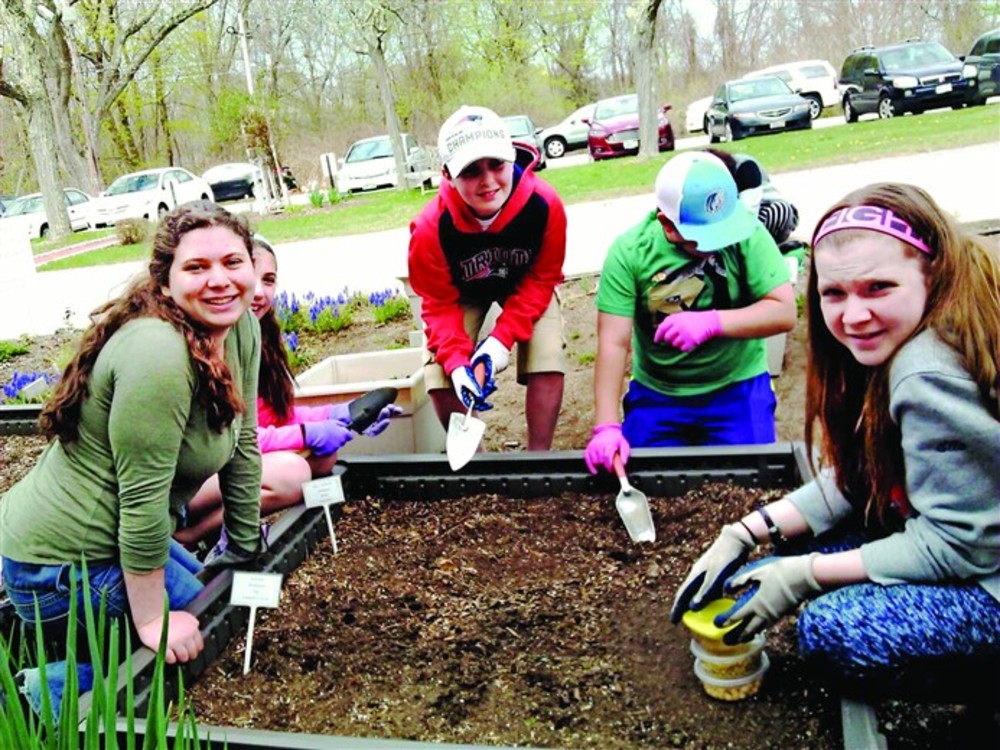Harvest in the Biblical Garden
 Religious school students from Temple Sinai help out in the garden. /Catherine Walters
Religious school students from Temple Sinai help out in the garden. /Catherine Walters
As the daylight hours grow short, summer gives way to fading flowers and leaves begin to turn in the Biblical Garden at Temple Sinai, a Reform congregation in Cranston. It’s been a summer of lush growth and abundance. Stalks of ancestral emmer (wheat) and barley are heavy with grain, and dyers’ madder and tansy run riot in the dye garden. The resident rabbits dine on bolted lettuce and baby toads have made themselves at home in the raised vegetable beds, to the delight of visiting children. The papyrus will soon come indoors for the winter, along with other frost-tender specimens. Chamomile, thyme, coriander and black cumin will continue to naturalize wherever their seeds fall.
One of the primary purposes of Temple Sinai’s Biblical Garden is to give religious-school students an opportunity to connect with the Land of Israel and Jewish tradition in a hands-on way, instilling stewardship of the plants and engagement in the ancient Israelite agricultural cycle of planting and harvest.
The design of the garden provides opportunities for demonstrating interactions between plants and people in biblical times – as foodstuffs and fodder, as textiles, and in sacred text and ritual. As a teacher resource, it encourages hands-on activities that enhance the religious-school curriculum. And for all who visit, the garden offers a seasonal display of shoshanim, wildflowers that flourished in ancient times – and still today – in Israel.
This fall, students will discover the results of last spring’s efforts: the herbs, tender vegetables and flowers they planted in May. They will harvest chickpeas, lentils and broad beans for the seed supply to be planted next spring, and they will help put the garden “to bed” for the winter. And at this time of year, they especially enjoy planting bulbs of allium, grape hyacinth and narcissus, and look forward to watching them emerge and bloom in the spring. It’s been a good year, and as the Yamim Noraim draw to a close, it will be time for the ingathering of Sukkot.
“And ye shall take you on the first day [of Sukkot] the fruit of goodly trees, branches of palm trees, and boughs of thick trees, and willows of the brook, and ye shall rejoice before the Lord your God seven days.” (Lev. 23:40).
The Biblical Garden is home to all four species of plants (palm, willow, myrtle and etrog) that comprise the lulav and etrog of Sukkot. Last year, after Sukkot, the fifth-grade religious school class, taught by Cantor Wendy Siegel, opened an etrog, examined the fruit and enjoyed its wonderful scent. They planted the seeds and germinated over a dozen little seedlings that were distributed to congregants on Tu b’Shevat, the “new year” for trees. One of those seedlings is now a specimen of the garden’s “goodly trees,” along with fig, pomegranate, almond and olive.
CATHERINE WALTERS is the coordinator of the Biblical Garden at Temple Sinai. Visitors are welcome. For more information, contact her at 401-419-7698.







